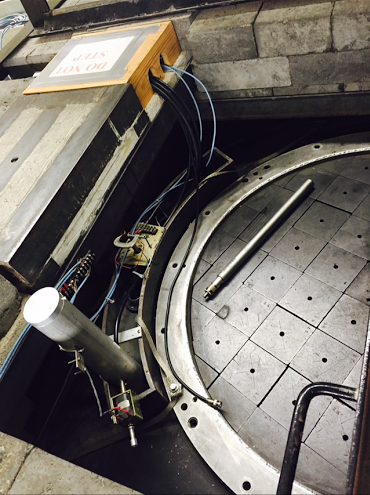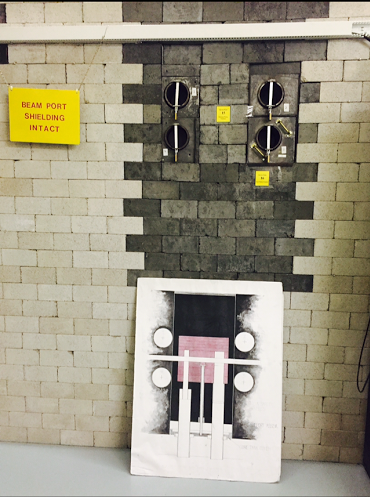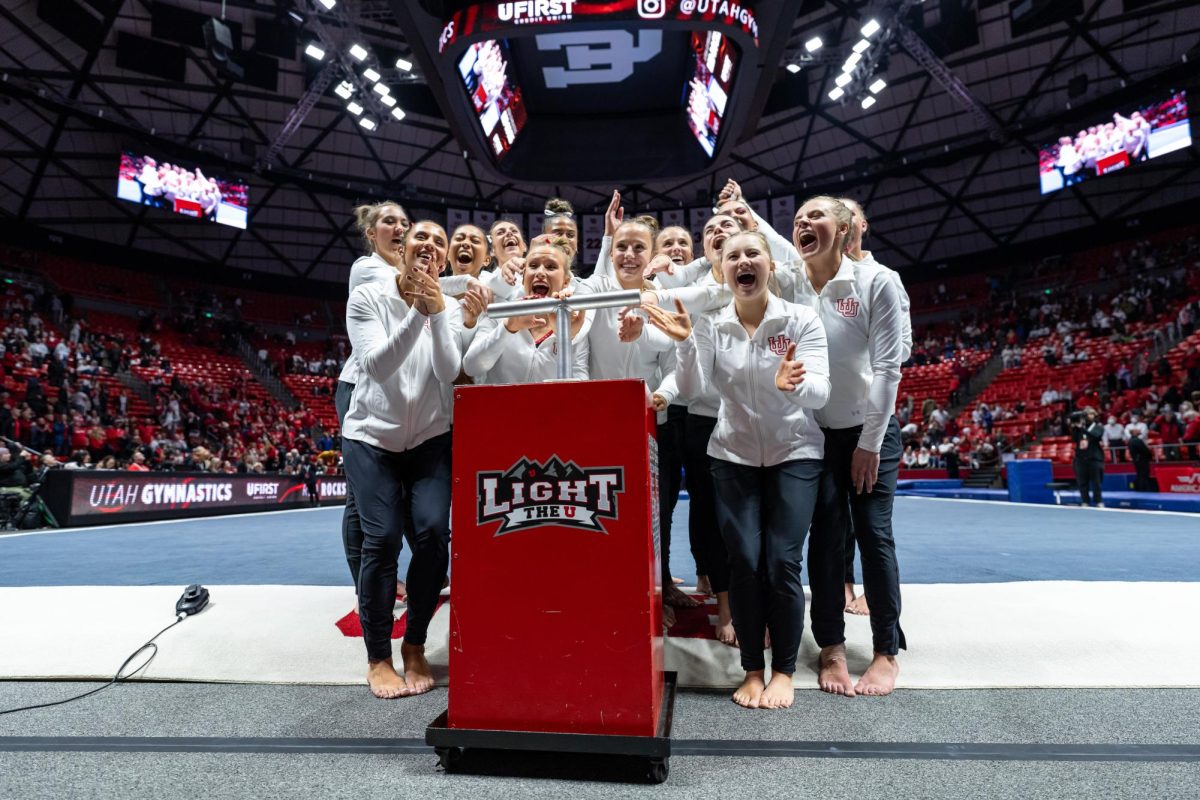Former U Professor Blows Whistle on Idaho State University Nuclear Violations

Idaho State University’s 5-watt nuclear reactor in May 2021. (Photo courtesy of Idaho State University)
March 31, 2023
Nuclear engineers have the second-fastest growing salaries among six-figure earners, according to the American Nuclear Society. Expanding university programs in nuclear energy has also been encouraged by the U.S. Department of Energy, who created the Nuclear Energy University Program in 2009 to “revitalize nuclear education” at U.S. universities.
Such dramatic growth, however, has led to some universities receiving violations from the Nuclear Regulatory Commission, a federal agency charged with regulating nuclear activity.
Kevan Crawford served as the nuclear reactor operations director for the University of Utah’s 100 kilowatt Training, Research, Isotopes & General Atomics reactor before taking a job at Idaho State University as reactor supervisor in December 1991.
“The contempt the NRC showed for the people of Idaho by knowingly allowing this to continue is beyond comprehension,” said Crawford.
Origins of the U’s 100 kilowatt TRIGA reactor
During his experience working in the U’s nuclear program, Gary Sandquist led construction of the reactor, which began in 1972. He worked as a professor of mechanical and nuclear engineering at the U from 1964 to 2007.
“I brought in the TRIGA reactor, which is a research reactor,” Sandquist said.
Since becoming active in 1975, Sandquist says the U’s TRIGA reactor has rarely been put into potentially dangerous circumstances. According to Sandquist, no real concern for safety has arisen from the reactor, despite numerous visits from the NRC.
On Sept. 17, 2022, an engineering student at the U threatened to detonate the reactor. While no tampering was done to the reactor, the student was arrested and booked for making terroristic threats four days following the initial threat.
According to a statement released by the U, all reactor personnel must undergo a background check and routine training.
“Everything you do has to be inspected because of safety issues and concerns,” Sandquist said, adding that an earthquake would pose the most danger to the 100-kilowatt reactor.
“It could possibly rupture the tank, empty the water and then the reactor … would provide a radiation dose to people right above the reactor,” Sandquist said.
According to Sandquist, safety measures were taken to protect folks from radiation in the event of an earthquake: the reactor was reinforced using an outer steel tank on top of the inner aluminum one, with large amounts of sand to fill the gap in between the two tanks and to act as a cushion during a seismic event.
Shortly after going critical, the U was cited with a notice of violation in 1979 by the NRC for failing to report reactivity measurements as well as deficiencies in their operations manual.
Sandquist says Crawford worked with him as a grad student at the U before being hired for a position at ISU.
Safety Violation Allegations
Upon arriving at ISU, Crawford claims to have found multiple safety violations involving ISU’s 5 watt Aerojet General Nucleonics nuclear reactor.
“They got me to leave the U and come up there and fix their program and the reactor without telling me all of the problems I would face,” Crawford said.
According to a petition for enforcement action against ISU filed in 2009, Crawford claims to have reported at least 30 violations to the NRC. Of the 30 violations, Crawford cites exposing students to a mixed-radiation beam and undocumented nuclear byproduct material transfers as the most pressing.
The complaint was reported to the NRC against ISU’s dean of the college of engineering, Harry Charyulu, and the previous reactor supervisor, Albert Wilson. Wilson also taught reactor physics at the time of the complaints.
“Wilson … proceeded to unlawfully distribute controlled by-product nuclear materials in undocumented … clandestine transactions, to unknown individuals,” Crawford said, citing Title 10 of the Electronic Code of Federal Regulations which states, “The licensee shall submit … a report containing a brief description of any changes, tests, and experiments, including a summary of the evaluation of each.”
According to Crawford, nuclear materials known as radiotracers, sometimes used for detecting nuclear weapon detonations, also have a biological weapon applications.
Such testing can be done by tagging a substance with light radiation. This is done by an irradiation in the AGN reactor to make the substance detectable using a gamma spectrometer. Researchers can then test how well the substance travels through the air by sending the lightly irradiated substance through a wind tunnel and testing for radioactivity downwind, Crawford said, citing his MS in nuclear engineering and BS in chemical engineering.
Similar research in aerosol testing has been done using DNA tagging in which DNA-tagged particles are used rather than an irradiated substance.
During his time at ISU, Crawford recounts witnessing such a test occur in a field south of Pocatello, ID, equipped with a field grade gamma spectrometer. Crawford also claims to have seen the same vehicle used during one of Wilson’s undocumented transactions at the Pocatello field test site.
Administrative Conflict
Sean Cunningham, a senior reactor operator at the time of the allegations, said, “[Wilson] was actually a really good professor,” adding that he was highly qualified for the position he was in.
Cunningham, who worked with both Wilson and Crawford, said it came down to a struggle between somebody recently out of school and somebody who had been practicing nuclear engineering since the late ’50s.
“They clashed as a matter of who had the best methods,” Cunningham said.
At one point during the dispute, the reactor was shut down for two days until an agreement could be reached between the two professors.
According to Cunningham, this clash came at a time of transitioning from regulation by the state of Idaho to the NRC.
“Dr. Crawford felt like Dr. Wilson had stepped outside the bounds on what the regulatory agencies allowed to happen,” Cunningham said.
Crawford said he played a key role during the transition to regulation by the NRC.
“I served as a working committee member on the standards committee in the 1980s,” Crawford said. “We wrote the first version of the standards that have subsequently undergone updating. … There was not a single copy of these standards at ISU when I was there.”
Cunningham said that Charyulu, the college of engineering dean, stepped in to try to mediate some of the issues.
Following the sudden passing of Charyulu in June 1994, Jay Kunze was hired to fill his role. Soon after his appointment, Kunze refuted Crawford’s claims in an op-ed published by the Salt Lake Tribune.
“The sub-critical facility associated with the reactor develops no measurable power. Both are benign nuclear devices, safe to operators, students and the public,” Kunze said, adding that ISU rejected the assertions by Crawford regarding the university’s lack of compliance with regulations and safety standards.
Exposed Radiation Beam
Known as the “Glory Hole,” many AGN reactors house direct access to the core of the reactor. According to Crawford, this exposes a radiation beam that was hazardous to students.
Cunningham, who also worked as a health physicist in ISU’s radiation safety office at the time of the allegations, said they had established protocols to ensure that students never entered the beam.
“Everybody was monitored for radiation,” Cunningham said. “I can tell you that no student was ever placed in a beam of radiation.”
According to Crawford, the beam went through a glass window and entered an uncontrolled open access study room where students frequently crossed.
“A personnel access went directly through the beam between the reactor and the console where the detector was positioned,” Crawford said.
He added that the detector was positioned off-center of the stream in order to reduce the reading to just below the NRC’s 5 millirem per hour limit. He also said the detector was only measuring gamma rays, though radiation from the core of the reactor is a mix of gamma rays, x-rays and particles of alpha, betas and neutrons.
“The 4 millirem per hour is not the total radiation, that’s just the gamma component … they’re actually exceeding the five millirem [limit],” Crawford said.
In his op-ed, Kunze described the ISU’s 5 watt AGN reactor as “tiny” and no threat to the public, saying, “The reactor is limited to power no more than that of a standard incandescent night light.” Crawford disputed this claim.
“5 watts does not generate enough fission products and byproduct nuclear materials to be a regional threat, but it does generate enough to be a facility threat and a personal contamination threat,” Crawford said. He added that the neutron source placed in the core access was also routinely handled without protective clothing.

Whistleblower Repercussions
In March 1993, Crawford resigned as reactor supervisor. Following his resignation, he filed a whistleblower complaint with the U.S. Department of Labor against the ISU administration. In response, investigators Jerrold Judkins and Jonathan Armenta were sent from the DOL and NRC respectively.
After meeting with the DOL, Crawford’s complaint was allegedly dropped without his consent.
“The DOL unlawfully proceeded to drop the complaint without my agreement to the new conditions,” he said.
After being deposed by the NRC, a notice of violation was issued against ISU. Violations cited in the document include failure to keep records of byproduct material transfers, failure to verify the authorization of persons to receive byproduct materials and failure to document irradiated material removed from the reactor.
ISU responded with a statement saying, “In 1993 the NRC did issue the notice of violation referred to by Crawford, and ISU immediately responded by taking corrective action in all areas noted.”
Both the NRC and Utah Rep. Burgess Owens denied records requests for the recording of the deposition, citing the lack of an administrative appeal to the decision being made within 90 days. Sen. Mike Lee’s office made no response.
“The NRC’s response … is a clear indication to the people that they have no idea what they are regulating,” Crawford said.
Recent Violations from NRC
In 2017, a notice was sent to the NRC by ISU administration regarding 1 gram of Pu-239 that went unaccounted for from the original 1991 supply.
In 2021, another notice of violation was issued by the NRC against ISU along with a $45,000 fine. Reasons for the penalty included failure to account for licensed material, failure to have a reactor safety committee review and approve procedures for usage of licensed materials, and failure to conduct inventory of all special nuclear material in possession.
In response to the notice of violation, ISU said, “At the time, the NRC noted that the University was already actively working to correct the issues and since then, the University has made substantial changes to improve all radiation safety practices. The NRC conducted a site visit in December 2022 and found all corrective action plans have been completed. The NRC then renewed our Special Nuclear Materials License, without conditions, for another 10-year period.”

In June 2022, Idaho State University announced its reception of over $1 million in grant money from the NRC through the University Nuclear Leadership Program.
“We take the safety of our community seriously and are continuously working to further improve our processes and protocols,” ISU said.












Dr Kevan Crawford • Mar 31, 2023 at 1:21 pm
The radio-biotracers were used for the optimization of an anthrax process (note: 5 unsolved murders of the US Senate anthrax attacks of Oct 2001). The great Albert Wilson physically assaulted the then Director of the Office of University Programs for the Dept of Energy, Keith Brown, which necessitated the hiring of Dr Crawford. Dr Crawford was so new that prior to ISU he had directed the nuclear operations at Texas A&M Nuclear Science Center, a facility as large as the entire ISU campus as well as the UofU reactor for 10 years prior to being an operator for 4 years. Just a little oversite, wouldn’t you say? And of course, we cannot mention the undocumented nuclear reactor running in the basement of the ISU Physics building because, well, it was undocumented. What about Professor Tony Campo, who left at the same time as Dr Crawford because of the hostile work environment that violated the national standard ANS-15.4. Source names and current phone numbers were provided for all of these incidents. Even the phone number of Paul Keim, the FBI’s anthrax DNA expert that was a post-doc at the UofU as well as the name and phone number for the son of the falsely accused Bruce Ivins. And of course, did call Jackie Gilpin to confirm that the neo-natal unit at the Bannock Regional Hospital was contaminated with radioactive materials from Albert Wilson’s lab. And that Albert Wilson failed on every occasion to obtain authorization to operate the reactor. Kind of an important regulatory violation, wouldn’t you say?
Dr Kevan Crawford • Mar 31, 2023 at 6:15 pm
ISU was found guilty of whistleblower retribution. Just slipped your mind? Mike had the ruling in his hands months before he wrote this piece. Only a mention of Jeff Judkins brother, Gerrold Judkins, a DOL investigator. No mention that the sworn deposition I gave was for a CRIMINAL INVESTIGATION of ISU. It should be pointed out that Sean Cunningham was a student at the time I was hired. Sean has no knowledge of my credentials. He is unqualified to make a comment as he was then nor since been a professor. The ONLY fact Sean can comment on is the illegal distribution of reactor fuel plates that were used in the illegal reactor in the basement of the Physics Building. It was Sean that told me where the plates were located during a physical inventory Feb 1992. And for Jay Kunze, he worked at the University of Missouri prior to 1996. He has no knowledge of the whistleblower events. Kunze has never held a license to operate ANY reactor and is therefore unqualified to make any comments on either whistleblowing or reactor operations. No mention of NRC Management Directive 11-8 because he knows nothing about it. The UofU Reactor Administrator has never made a comment on reactor operations since first criticality on Oct 25, 1975. There is a reason for that. It’s called PROFESSIONAL CODE of ETHICS. It is p[rohibited to ethical professionals to make public comments without a license. So there were no credible sources cited to give any credibility to ISU because no credible sources exist. Kind of extremely important, don’t you think? I still want to hear from Keith Brown, and ISU graduate. He sanctioned the ISU College of Engineering. Kind of important to know why, don’t you think? No? Why? because it might reveal a truth? Well, we certainly don’t want to expose the truth in an investigative piece, right? Let’s hear from Keith Brown, and the other 25+ witnesses who support my expert eyewitness accounts. BTW, Mike had the names and addresses handed to him. He didn’t even have to work for them. They just fell into his hands, yet no contacts were made. He could have even found some of them on facebook by pressing a few keyboard keys. I know because I did.
Dr Kevan Crawford • Apr 1, 2023 at 12:48 pm
Sean Cunningham could not pass the requalification exam required by 10CFR55. Funny how he endorses Albert Wison, who FAILED the requalifying exam. And Kunze never took an operator’s exam in his entire life and therefore certainly could NOT have passed the test created by me. And the ISU Supervisor in the late 1990’s was one and the same supervisor that got the UofU reactor shutdown in April 1988. All one has to do is research and read the Chrony, the SL Tribune, and the D-News to know that. President Dave Pershing hired me back from Texas A&M to fix that screwed up situation.
The crackpots at ISU were teaching that the AGN reactor shut itself down after 6 hours of operation. That’s called xenon poisoning for competent scientists who can pass an operators exam. Also, they were teaching that the negative temperature coefficient is caused by hardening of the neutron spectrum with increased temperature. Competent scientists who can pass an operators exam know that negative temperature coefficient is caused by the doppler broadening of the resonance absorption peak in Uranium fuels. Teaching fake science to create dangerous engineers was their strength. Operating reactors safely was not their forte or interest.
M Jewkes should have qualified the credentials of his interviewees and published those credentials, or lack thereof, along with their statements. That how credible reporting is done.
And most interesting of all is that all news was censored of any mention of the United States Information Service (USIS) News Release of the People of the United States awarding me with a Fulbright Senior Fellowship 1994-1995 to teach law in Russia for having blown the whistle on a viper’s nest of felony perpetrators. M Jewkes has a copy of the news release. Why not? Inquiring minds want to know why ANYBODY would censor a federal government news release. The M Jewkes could have at least scanned my lifetime membership card in the Fulbright Association and included it in the report. But no. We can’t mention that relevant FACT.
But we can’t report the whole truth because we have to “balance the reporting” (the words of M Jewkes) one-for-one statements, forget the fact that there is a preponderance of evidence condemning the perpetrators. Truth loses once again to an ill-conceived idea of fairness. Facts are not fair. They have no moral judgement. They just are reality. And you can bet the farm that federal documents do exist. And signatures on fraudulent operating reports and inventory reports do exist. And altered sworn deposition transcripts do exist as M Jewkes saw and held in his hands. Why hide the documents from public scrutiny?
We’ll now get to see where this goes next and how the reporting stands the test of time.